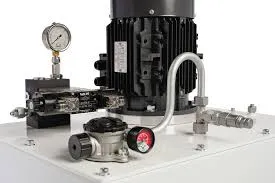Nov . 17, 2024 23:24 Back to list
hydraulic cylinder bleeding product
Hydraulic Cylinder Bleeding An Essential Maintenance Practice
Hydraulic systems are integral to a variety of industries, from manufacturing and construction to automotive and aerospace. These systems rely on hydraulic cylinders to convert fluid power into mechanical force, enabling equipment to perform heavy lifting and intricate movements with precision. However, a common issue that can arise in hydraulic systems is the presence of air trapped within the hydraulic cylinders. This phenomenon can lead to inefficient operation, reduced performance, and even costly damage if not addressed promptly. Therefore, periodic bleeding of hydraulic cylinders is essential for maintaining optimal performance and longevity of the equipment.
Understanding Hydraulic Cylinder Bleeding
Hydraulic cylinder bleeding is the process of removing air or gas bubbles from the hydraulic fluid within the cylinder. Air trapped in the hydraulic system can lead to problems such as spongy or unresponsive movements. This occurs because air is compressible, unlike hydraulic fluid, which is incompressible. When air enters the system, it alters the pressure dynamics, causing the hydraulic cylinder to fail to deliver the expected force or motion. Factors contributing to air ingress can include leaks in hoses or seals, low fluid levels, or improper system assembly.
Why Is Bleeding Necessary?
1. Enhanced Performance The primary reason for bleeding hydraulic cylinders is to ensure smooth and responsive operation. Air in the system can cause lag in movement, leading to ineffective operation, especially in applications requiring precision. By removing air, the hydraulic system can function as intended, providing reliable power and control.
2. Preventing Damage Prolonged operation with air in the hydraulic system can lead to cavitation—an effect where vapor bubbles collapse and generate shock waves. This can cause significant wear and tear on the cylinder components, leading to costly repairs and downtime. By routinely bleeding the system, you can mitigate the risk of damage.
3. Increased Efficiency A hydraulic system operating with air in its fluid is less efficient, consuming more energy to perform the same tasks. This inefficiency not only raises operational costs but can also lead to overheating and additional strain on the system. Keeping the hydraulic fluid free of air helps maintain energy efficiency.
How to Bleed a Hydraulic Cylinder
The process of bleeding a hydraulic cylinder is relatively straightforward but requires attention to detail
. Here’s a step-by-step guidehydraulic cylinder bleeding product

1. Safety First Ensure the system is not under pressure. Disconnect the power supply and release any built-up pressure in the hydraulic lines.
2. Locate the Bleed Valves Identify the bleed valves on the hydraulic cylinder. These are typically located at the top of the cylinder or near the hydraulic lines.
3. Open the Bleed Valves Using the appropriate tool, carefully open the bleed valves. Allow the hydraulic fluid to escape, and watch for air bubbles in the fluid.
4. Cycle the Cylinder Gently cycle the hydraulic cylinder (if safe to do so) to move the hydraulic fluid and facilitate the removal of air.
5. Close the Valves Once you see a steady stream of fluid without bubbles, close the bleed valves securely.
6. Check Fluid Levels Recheck the hydraulic fluid levels and top off as necessary to ensure the system has sufficient fluid for operation.
7. Test the System Once everything is securely in place, restore power to the system and test the cylinder to ensure it operates smoothly.
Conclusion
Regularly bleeding hydraulic cylinders is a crucial maintenance task that should not be overlooked. Ensuring that your hydraulic system is free of air not only enhances performance and efficiency but also protects against potential damage. By taking the time to maintain your hydraulic cylinders, you can extend the lifespan of your equipment and avoid unexpected downtime, leading to increased productivity and lower operational costs.
-
High-Performance Set of 50/60-45-290 471 | Durable & Reliable Components
NewsAug.26,2025
-
Efficient Pallet Truck Power Units - Reliable Hydraulic Systems
NewsAug.25,2025
-
Premium Set of 50/60-45-290 471 Parts | High Performance
NewsAug.24,2025
-
Efficient & Reliable Double Acting Power Unit | Hydraulic Solutions
NewsAug.23,2025
-
1.5 Ton Turbocharged Cylinder 80/95-40/60-35-124 | High Performance
NewsAug.22,2025
-
High-Performance Fork Lift Hydraulic Power Units
NewsAug.21,2025
